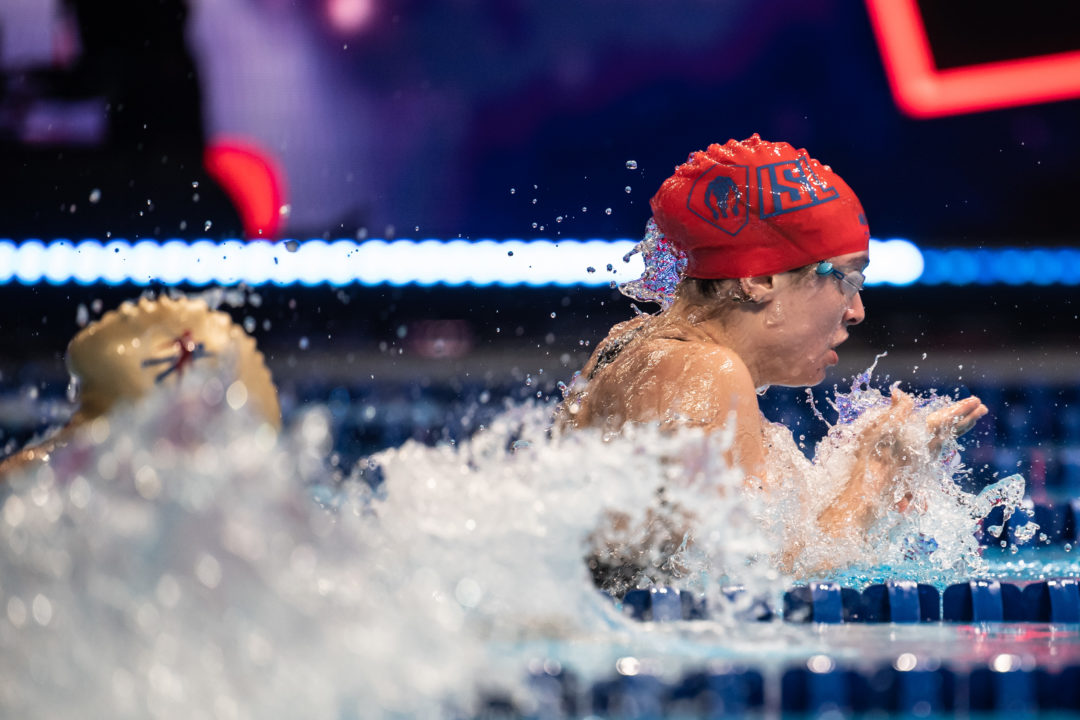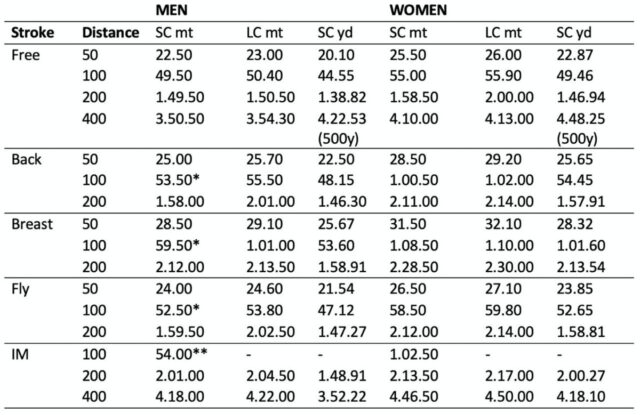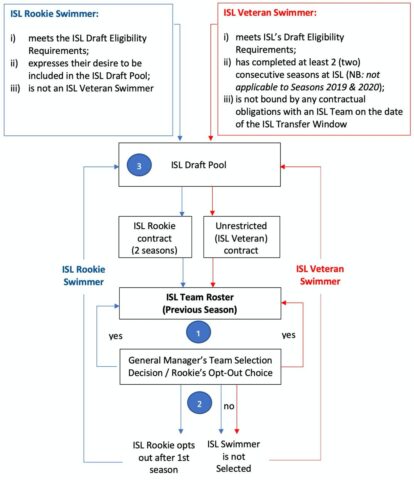The International Swimming League (ISL) has released more details on its draft process. One important piece: only the two non-playoff teams from last year will get 1st-round picks.
2021 will be the first season in which the ISL will hold a draft to determine rosters. Teams are still able to retain up to half of their 2020 rosters via several rounds of swimmer protection. We break down all the steps below:
Pre-Draft
Each GM must announce 5 pre-selected athletes from their 2020 roster to retain for 2021. Each GM must announce the names publicly at least 7 days before day 1 of the ISL draft.
Day 1 of Draft
Round 1 of retention: Each GM announces 4 more swimmers to retain.
Round 2 of retention: Each GM announces 3 more swimmers to retain.
Round 3 of retention: Each GM announces 2 more swimmers to retain.
Round 4 of retention: Each GM announces 1 more swimmer to retain.
This multi-round system could force some on-the-fly decision-making. For example, if breaststrokers around the league are being retained, a team may pivot to retain its own breaststrokers, seeing that the draft pool is getting thin in that event.
*GMs can retain up to 15 swimmers, but aren’t required to retain all 15. So a team that wants to turn its roster over from last season can choose not to retain the maximum number of swimmers in any of these rounds.
All unretained athletes join the ISL Draft Pool, along with any new additions to the ISL.
*Note: it’s still unclear whether teams can retain athletes who were announced to a roster last year but did not ultimately compete. That would include many of the top Australian swimmers, especially on the London Roar.
Round 1 of Draft: GMs of the lowest-finishing teams get to select 1 swimmer each from the ISL Draft Pool:
- Lowest-ranked team from the previous season gets the #1 pick.
- In 2021, this would be the Aqua Centurions
- Second-lowest-ranked team from previous season gets the #2 pick
- In 2021, this would be the DC Trident
*Not every franchise will have a draft pick in every round, as explained more in day 2 below.
Fan Voting Opens: After the first round of the draft, the ISL will open a fan vote, allowing each team to retain 1 more athlete from their 2020 roster. In order to vote, fans will have to (1) register on the ISL platform and (2) purchase a subscription to stream either the full ISL season, or one team’s specific matches.
Each registered fan will get one vote to cast for one team to retain a swimmer from 2020.
End of Day 1.
Day 2 of Draft
Fan-Vote Players Retained: The ISL will kick off the day by announcing the results of fan voting, and which players will be retained to their 2020 teams through fan votes.
ISL Draft Continues: the draft will continue with 13 more rounds. One important note is that not every team will have a pick in every round. The lowest-finishing teams from the previous season get picks in the early rounds, and the top teams don’t get picks until much later. We’ve visualized the pick order below, with the team numbers referring to each team’s final rank in the previous ISL season:
| Pick # | Round 1 | Round 2 | Round 3 | Round 4 | Rounds 5-10 | Round 11 | Round 12 | Round 13 | Round 14 |
| 1 | #10 Team | #10 Team | #10 Team | #10 Team | #10 Team | #8 Team | #6 Team | #4 Team | #2 Team |
| 2 | #9 Team | #9 Team | #9 Team | #9 Team | #9 Team | #7 Team | #5 Team | #3 Team | #1 Team |
| 3 | #8 Team | #8 Team | #8 Team | #8 Team | #6 Team | #4 Team | #2 Team | ||
| 4 | #7 Team | #7 Team | #7 Team | #7 Team | #5 Team | #3 Team | #1 Team | ||
| 5 | #6 Team | #6 Team | #6 Team | #4 Team | #2 Team | ||||
| 6 | #5 Team | #5 Team | #5 Team | #3 Team | #1 Team | ||||
| 7 | #4 Team | #4 Team | #2 Team | ||||||
| 8 | #3 Team | #3 Team | #1 Team | ||||||
| 9 | #2 Team | ||||||||
| 10 | #1 Team |
*For 2021, the #10 team would be the Aqua Centurions and the #9 team the DC Trident.
Post-Draft
For 30 days* after the ISL draft, GMs can negotiate with remaining swimmers to fill out their rosters. GMs can only sign athletes from the ISL Draft Pool.
*In future seasons, the signing period will be 60 days. For 2021, the period is shortened to allow for international travel arrangements amid the ongoing pandemic.
Other notes:
- Athletes must be at least 18 as of registration to join the ISL draft pool.
- This is a major development, as junior athletes have previously held big roles in the ISL. Notably, Benedetta Pilato was the #32 overall scorer in the league last year at the age of 15. Based on these rules, she’d be blocked out of the ISL until the 2023 season.
- ISL teams must have 24 swimmers on their roster – 12 men and 12 women.
- Rosters can have up to 36 total athletes.
- The ISL has also established cutoff times for eligibility to enter the draft. The times aren’t particularly fast for a professional swimming league (the short course yard times are considerably slower than what it takes to earn an NCAA invite), and mostly appear to be a baseline to keep the draft pool from getting too large. The cutoff time table is shown below:
*Athletes must hit these times between January 1, 2018 and May 31, 2021. Athletes must better the cutoff time in at least 3 different events. (Different courses of the same event still count as one event, so athletes can’t make the 50 free in SCY, SCM and LCM and count it as three events).
Veterans vs Rookies
The new ISL rules also show how the league plans to handle contracts and free agency in future seasons. The ISL has created two categories for athletes: rookies and veterans.
Veterans have competed in the ISL in either 2019 or 2020. In future seasons, a veteran swimmer will be an athlete who has competed in 2 ISL seasons with an ISL team.
Rookies are all athletes who aren’t veterans. That should include brand-new ISL swimmers, whether they just turned 18, turned pro out of the NCAA, or simply didn’t compete in the ISL in past seasons. Beyond 2021, rookies will remain “rookies” for their first two seasons in the league.
Veteran Contracts
There will be a 60-day window after the end of the ISL season in which ISL veterans can negotiate with the GM of any team – though that is subject to specific contractual agreements. That suggests a sort of “free agency” period in which veterans not under contract can negotiate and sign anywhere. It may also lead to multi-year contracts for athletes (to keep them from free agency), or clauses in contracts governing the negotiation with teams during that free agency window.
Rookie Contracts
All rookies will be required to sign a two-year contract with an ISL team. After the first year, rookies have the option to opt out of their contract and sign a separate two-year contract without the opt-out possibility.
So, for example, an ISL rookie drafted this year will sign with a franchise for 2021 and 2022. If after 2021, they want to switch teams or adjust their contract, they can opt out of the second year, but will have to sign a new two-year deal for 2022 and 2023, with no chance of opting out before the 2023 season is over.
Here’s a flow-chart from the ISL site to explain the system:



There are many very good reasons for 18-over rule. On top of my mind is that it would emphasize a healthy progression, even in swimming. Swimmer should be at their peak at 25-30, not 15. This is the case in most endurance sports, where 23- under is junior class.
Good move by ISL
What provision is ISL making for pregnancy in distinguishing veteran from rookie? There’s an increasing trend in professional sports to protect the status/ranking of female athletes who take one or two seasons off for pregnancy and recovery. Could cost an athlete quite a bit of money if they’re reclassified as a rookie.
Everyone is talking about Pilato, but I want to see more of that young male 200 Butterflyer that was giving Tom Shields and Chad LeClos a run for their money. Can someone remind me his name? I think he was 16 last year.
I too am against the 18 and over rule. Mainly because for many swimmers, their window to cash in on their peak can be so short lived. Swimmers like Ruta Meilutyte, Pilato, Dagny Knutson, Michael Andrew, etc. who chose to go pro, have no idea how long their window to compete may be and should not be restricted in their opportunities. Who knows how much money swimmers like Ledecky, Missy and Simone who delayed going pro… Read more »
Danny was over 18 when she chose to go pro ( having taken bad advice ) But this is not a problem for non NCAA swimmers .
There is no reason under 18 s cannot receive prize money , because they do at FINA events . But of course FINA are the bad guys .
Let’s say I, as a viewer, am interested in a streaming subscription… will it actually work/show the races? Because last season was a mess…
The 3 cutoff times can be tricky to some event specialists. For example Kenderesi only cleared the 100 and 200 fly times since 2018 (he was under 24.6 in the 50 LCM fly and under 1:49.5 in the 200 SCM free in 2017 but not since).
‘Swimmers must be 18 as of registration to enter the draft pool.’ so, could teams choose to retain under-18 swimmers (eg. Energy retains Pilato) so that they won’t enter the draft pool?
That’s what I wanna know. It wouldn’t surprise me for Grigorishin to leave a loophole so Energy can retain their star breastroker.
I agree with the “18-year old” minimum age. Minors (below 18) should not be eligible for “professional” status.
I agree. It is also an unreasonable emotional and physical burden to put on a minor. No matter how gifted they might be.
In some sports you peak before being 18, and only go downhill from there, like gymnastics when you’re a women. So it doesn’t make that much sense.
Thank you. This rule just seems to hurt women much more. I think of swimmers like tuna Islamic who were competing at the world stage level of competition as young as 12-15 who haven’t gotten significantly faster after turning 18 and wonder how much more financially secure they’d be if they had a chance to make money during those years from the sport.
“tuna Islamic” – best autocorrect I’ve seen in a while lol.
Same! And there’s actually a lot of really deep dives on the internet on whether it is or not!
Ah yeah just screw swimmers like Pilato right? This rule especially hurts female swimmers with earlier primes
???
Female swimmers tend to enter their prime earlier than males, many of whom can be before the age of 18 before plateauing in their early 20’s. Restricting folks from competing under 18 limits the time frame that female swimmers at that highest level can make money as an athlete.